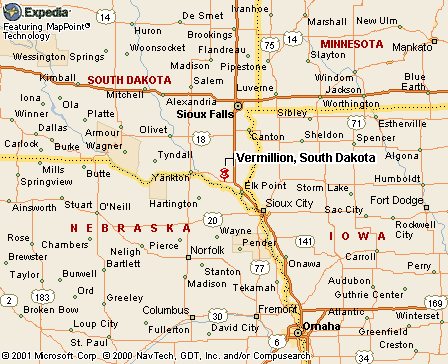|
|
Canku Ota |
|
|
(Many Paths) |
||
|
An Online Newsletter Celebrating Native America |
||
|
June 29, 2002 - Issue 64 |
||
|
|
||
|
Native American Journalists Hone Skills |
||
|
by Lisa Chamley P&D
City Editor
|
||
|
|
| VERMILLION, SD - For Pine Ridge
native Tasiyagnunpa Livermont, a three-week American Indian Journalism
Institute course is a chance to pursue an ideal.
"I've always like writing, and I'm addicted to the truth," said Livermont, a South Dakota State University journalism student and one of 26 Native American students enrolled in the class. "I think it's important just having a native or other minority in the newsroom. You make people stop and think. You're right there, you're in their face," she said. "I think it helps keep them honest. I think it contributes to the truth." The AIJI is funded by the Freedom Forum Neuharth Center and co-sponsored by USD's Department of Contemporary Media and Journalism, chaired by Ray Chavez. "The primary goal would be to increase the pool of talent. We know the talent is out there," said Chavez. "The second goal is to provide a voice to a community that often doesn't have a voice." The students, university students from Oregon to Maryland to Canada who represent 21 different tribes, are taught the basics of journalism and enjoy a smorgasbord of unique opportunities. On Wednesday, photography-oriented students took pictures of gubernatorial candidate Jim Abbott, who spoke at Pro's Restaurant in Vermillion over the lunch hour. Today, a visit is planned to the Winnebago Reservation in Nebraska; on Friday, Gov. Bill Janklow meets with the students; next week, USA Today founder and University of South Dakota alumni Al Neuharth and Morris Communications president Will Morris will speak. The students also meet and shadow prominent state and national Native American journalists, and have faculty and staff as mentors. The program's purpose is to encourage Native American students to pursue careers in the media, said Jack Marsh, director of both the Neuharth Center and the AIJI. "Native Americans are the most underrepresented population in American newsrooms," he said. "It's a deplorable situation." With the lack of diversity in newsrooms comes a failure to cover minority issues, he said. Of the 55,000 journalists working for the nation's daily newspapers, only 300 are Native American. That's less than 1 percent. South Dakota's Native American population is roughly 10 percent of the populace, yet only two daily newspapers in the state have Native Americans in the newsroom. More Native Americans in newsrooms would make better newspapers with "more accurate, balanced, fair coverage." "We think this program can make a difference," said Marsh. "As journalists, we all bring our experiences and our culture with us. The experience of these students may be different from non-native journalists, but the fundamentals of good journalism are the same." Chavez, who is both Hispanic and Native American, assembled the course using his 30 years of experience in journalism, teaching and various journalism-related organizations. He was one of four involved in a Freedom Forum fellowship program last year that assessed the journalism opportunities available to minorities in the nation's universities. Chavez said they found the opportunities and efforts to recruit Native American students vary widely. The AIJI program offered at USD is the only one of its kind in the nation. He noted that by having Native Americans in newsrooms, the issues that are important to that community have a better chance of being covered. That allows an Indian community "to place their concerns on the agenda of the public at large," Chavez said. "There can be a perception that the story is overtold," he said. He said that because Native American issues have been underreported in the past, to see them in newspapers now may appear to be "overreporting." "News is still news. An issue still has to be important to be covered," he said. News organizations have a responsibility to cover their entire community, Chavez said, noting Sioux Falls has a growing black and Hispanic population. Native American issues from all over the country are often brought up during the class, from the alcohol-related controversy in Whiteclay, Neb., to water rights and other issues. Kaeleen McGuire, an Oregon native attending school in Colorado, said there are misconceptions and prejudices that need to be corrected. "I've noticed since I was a little girl the wrongs in the paper or on TV," she said. A popular perception now is that the tribes are wealthy now because of gaming, or that because she is Native American she receives many things for free. Chavez said many Native American students often go into law or medicine because the effects of those careers can be readily measured in helping their people. "A lot of parents don't tell their kids you can contribute to the your community [through] the mass media," he said.
|
|
|
||
|
|
||
| Canku Ota is a free Newsletter celebrating Native America, its traditions and accomplishments . We do not provide subscriber or visitor names to anyone. Some articles presented in Canku Ota may contain copyright material. We have received appropriate permissions for republishing any articles. Material appearing here is distributed without profit or monetary gain to those who have expressed an interest. This is in accordance with Title 17 U.S.C. section 107. | ||
|
Canku Ota is a copyright © 2000, 2001, 2002 of Vicki Lockard and Paul Barry. |
||
 |
 |
|
|
The "Canku Ota - A Newsletter Celebrating Native America" web site and its design is the |
||
|
Copyright © 1999, 2000, 2001, 2002 of Paul C. Barry. |
||
|
All Rights Reserved. |
||
